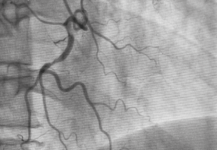Angioplasty by transradial access was discussed during a session on Day 2. We were pleased to participate in a conference by Dr. Shigeru Saito on distal radial access. Currently, complications associated with transfemoral access are well-established, so transradial access is suggested as the initial strategy in several guidelines of various associations. However, Dr. Saito shared…
Transfemoral vs Transradial Approach in the Percutaneous Treatment of CTO
Percutaneous treatment of chronic total occlusion (CTO) has traditionally been via the transfemoral approach (TFA). The use of the transradial approach (TRA) in complex coronary interventions has been increasing. A randomized study assessed the use of TRA vs TFA in complex PCI (58% CTO) and TRA saw favorable outcomes. The aim of this prospective, randomized,…
RESTORE | Using Rivaroxaban to Prevent Radial Artery Occlusion After an Intervention
Radial access has long demonstrated its benefit, but one of its most feared complications is radial artery occlusion (RAO), which can vary from 1% to 5% according to different series. There is currently no significant information on post-procedural anticoagulation and the presence of RAO at follow-up. The aim of the randomized RESTORE study was to…
EuroPCR 2021 | COLOR: Complex PCI via Transradial vs Transfemoral Approach
Treating total occlusions, complex bifurcations, grossly calcified lesions or left main lesions via transradial approach is associated with significant reduction in access-site bleeding or vascular complications vs transfemoral approach. This kind of procedures have been typically excluded from studies randomizing patients to transradial vs transfemoral approach. The COLOR study used the transradial bore-guiding catheter Glidesheath…
MATRIX: Impact of Crossover from Radial Access to Femoral Access
The new MATRIX trial, recently published in JACC Interv., shows that an access-site crossover from radial to femoral access in patients with acute coronary syndrome cancels out the benefit provided by radial access as regards bleeding. However, there are no signs of comparative damage between successfully conducted radial or femoral access as a first attempt. …
Pending Challenges in Transradial Access
The recent SAFARI-STEMI study compared transradial and femoral access in patients with ST-segment elevation myocardial infarction, and no significant differences were found. These results have a sour taste for those in favor of transradial access, as they are convinced of its benefits and unwilling to go back to previous practices. This bitter taste is based…
The Transradial Approach Continues to Be the Best for Primary PCI
The transradial approach has been associated to lower mortality and bleeding rates in patients receiving primary PCI for ST elevation MI. This had been called into question by the recent SAFARI-STEMI, but after including its outcomes in a new meta-analysis, the scales tilted slightly in favor of the transradial approach vs. the transfemoral. The transradial…
TAVR: Should Transradial Approach be the Second Access Site?
Courtesy of Dr. Carlos Fava. One of the major challenges we interventional cardiologists still face is access management. Reduced device diameter and improved transcatheter closure, together with increased operator experience, have significantly reduced vascular complications. However, we shouldn’t lose sight of the secondary access, usually transfemoral, generally used in case of primary access site related…
International Consensus to Prevent Radial Artery Occlusion After Interventions
This study provides the steps to follow in order to prevent or at least reduce radial artery occlusion after using it as an access for a diagnosis or treatment study. The use of transradial access is exponentially increasing worldwide due to its lower chance of bleeding events and vascular complications than transfemoral access. Radial artery…
ACC 2019 | SAFARI: Unexpectedly, Radial Approach Offers No Benefits In STEMI
This study was not able to show benefits in terms of mortality or bleeding when using radial vs. femoral approach in patients undergoing ST elevation myocardial Infarction. This small trial does not change things for “radialists” way past their learning curve who already feel confident with this technique. For them, there is no way back.…








